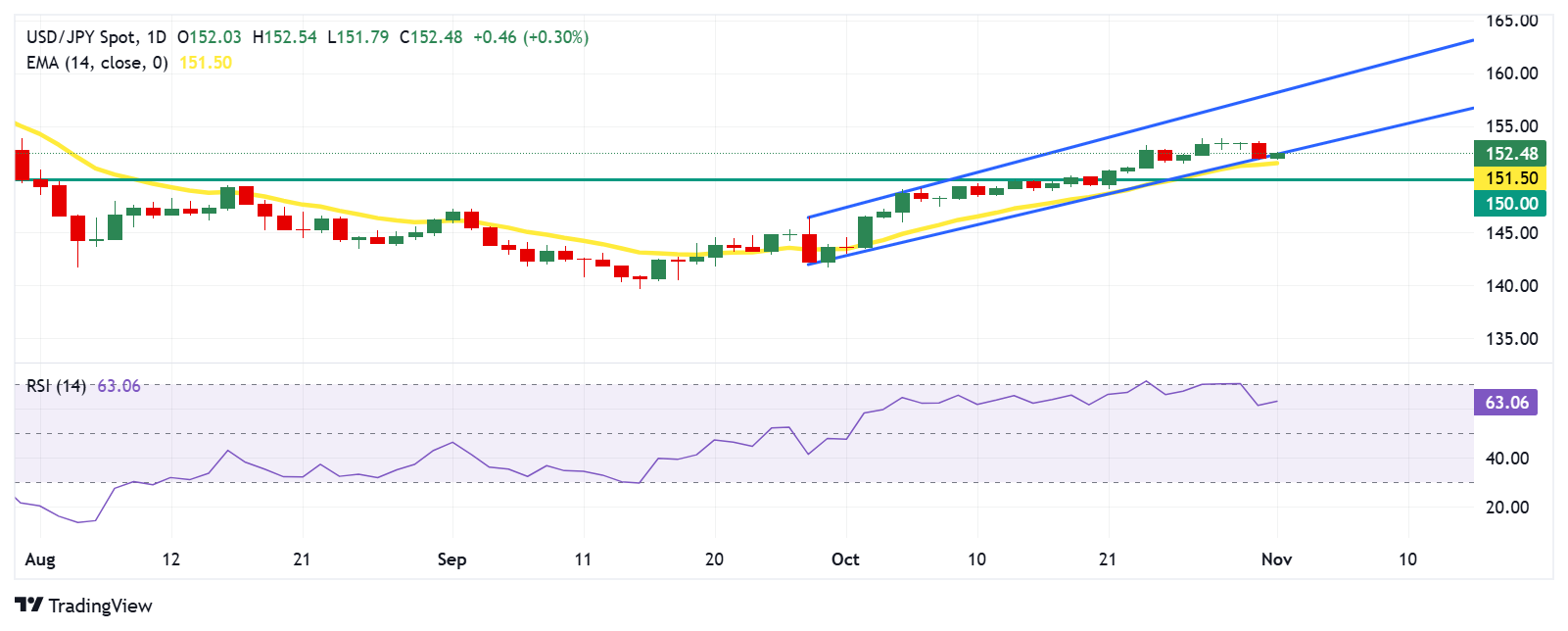- The Japanese Yen depreciated following the publication of the manufacturing PMI on Friday.
- Japan’s Jibun Bank Manufacturing PMI stood at 49.2 in October, reflecting a decline from 49.7 in September.
- US nonfarm payrolls are expected to increase by 113,000 jobs in October, a decrease from the previous count of 254,000.
The Japanese Yen (JPY) gives back some of its recent gains following the release of the manufacturing Purchasing Managers’ Index (PMI) by Jibun Bank and S&P Global on Friday. However, the USD/JPY fell as the JPY strengthened following Bank of Japan (BoJ) Governor Kazuo Ueda’s post-meeting comments on Thursday, which were seen as increasing the likelihood of a rate hike in December.
Japan’s Jibun Bank Manufacturing PMI stood at 49.2 in October, indicating a decline from 49.7 in September. This single-figure composite indicator shows that Japanese manufacturing production continued to decline at the start of the fourth quarter of 2024, with both production and new orders declining at steeper rates.
Japan’s Chief Cabinet Secretary Yoshimasa Hayashi stated on Friday that he anticipates that the Bank of Japan will work closely with the government to implement an appropriate monetary policy aimed at achieving its price target in a sustainable and stable manner.
Traders are anticipating the release of the US nonfarm payrolls (NFP) report on Friday, with expectations that the US economy will have added 113,000 jobs in October, while the unemployment rate is expected to remain stable in 4.1%.
Daily Market Summary: Japanese Yen Depreciates Despite Higher Chances of BoJ Rate Hikes
- The USD/JPY pair gains ground as the US Dollar (USD) breaks its four-day losing streak due to continued market caution amid uncertainty ahead of the upcoming US presidential election. However, the The dollar encountered difficulties after the publication of data from the Personal Consumption Expenditure Price Index (PCE) on Thursday.
- The US Personal Consumption Expenditure (PCE) Price Index showed that core inflation rose 2.7% year-on-year in September. Additionally, initial jobless claims fell to a five-month low of 216,000 for the week ending October 25, signaling a robust labor market and dampening expectations of imminent rate cuts by the Federal Reserve (Fed ).
- The Bank of Japan decided to keep its short-term interest rate target at 0.25% following the conclusion of its two-day monetary policy review on Thursday. This decision was in line with market expectations of maintaining stability.
- According to the BoJ’s Third Quarter Outlook Report, the central bank plans to continue raising policy rates as long as the economy and prices align with its forecasts, particularly given that real interest rates are currently very low. The Bank of Japan aims to conduct monetary policy with a focus on sustainably and stably achieving its 2% inflation target.
- Annualized US Gross Domestic Product (GDP) expanded 2.8% in the third quarter, below 3.0% in the second quarter and forecasts of 3.0%. ADP’s employment change report showed 233,000 new workers were added in October, marking the largest increase since July 2023. This followed an upward revision to 159,000 in September and significantly exceeded forecasts of 115,000.
- On Tuesday, the U.S. Bureau of Labor Statistics (BLS) reported that JOLTS job postings reached 7.443 million in September, down from 7.861 million in August and missing the market expectation of 7.99 million.
- Japan’s Economy Minister Ryosei Akazawa commented on Tuesday that a weaker yen could raise prices through higher import costs, which could reduce real household incomes and lower private consumption if wage growth fails. follow the rhythm.
- Japan’s Liberal Democratic Party (LDP) coalition lost its parliamentary majority in Sunday’s election, raising uncertainty over the Bank of Japan’s (BoJ) rate hike plans.
Technical Analysis: USD/JPY could re-enter the ascending channel to strengthen its bullish bias
The USD/JPY pair is trading around 152.40 on Friday. Daily chart analysis indicates a possible weakening of the bullish bias as the pair has broken below its ascending channel. However, the 14-day Relative Strength Index (RSI) remains above the 50 mark, suggesting that bullish momentum is active.
In terms of resistance, the USD/JPY pair is facing resistance at the lower boundary of the ascending channel, which is located at the 152.50 level. If the pair manages to re-enter this channel, it could target the upper bound around the 158.30 level.
To the downside, support for the USD/JPY pair could be found around the 14-day EMA at the 151.50 level, with additional support around the psychological level of 150.00.
USD/JPY: Daily Chart
Japanese Yen PRICE Today
The table below shows the percentage change of the Japanese Yen (JPY) against major currencies today. Japanese Yen was the weakest currency against the New Zealand Dollar.
| USD | EUR | GBP | JPY | CAD | AUD | NZD | CHF | |
|---|---|---|---|---|---|---|---|---|
| USD | 0.05% | -0.00% | 0.29% | -0.05% | 0.06% | -0.07% | 0.06% | |
| EUR | -0.05% | -0.05% | 0.25% | -0.08% | 0.02% | -0.09% | 0.01% | |
| GBP | 0.00% | 0.05% | 0.31% | -0.04% | 0.06% | -0.05% | 0.03% | |
| JPY | -0.29% | -0.25% | -0.31% | -0.34% | -0.24% | -0.36% | -0.25% | |
| CAD | 0.05% | 0.08% | 0.04% | 0.34% | 0.09% | -0.01% | 0.07% | |
| AUD | -0.06% | -0.02% | -0.06% | 0.24% | -0.09% | -0.11% | -0.03% | |
| NZD | 0.07% | 0.09% | 0.05% | 0.36% | 0.00% | 0.11% | 0.08% | |
| CHF | -0.06% | -0.01% | -0.03% | 0.25% | -0.07% | 0.03% | -0.08% |
The heat map shows percentage changes for major currencies. The base currency is selected from the left column, while the quote currency is selected from the top row. For example, if you choose the Japanese Yen from the left column and move along the horizontal line to the US Dollar, the percentage change shown in the box will represent the JPY (base)/USD (quote).
The Japanese Yen FAQs
The Japanese Yen (JPY) is one of the most traded currencies in the world. Its value is determined broadly by the performance of the Japanese economy, but more specifically by the policy of the Bank of Japan, the differential between the yields of Japanese and US bonds or the risk sentiment among traders, among other factors.
One of the mandates of the Bank of Japan is currency control, so its movements are key for the Yen. The BoJ has intervened directly in currency markets on occasion, usually to lower the value of the Yen, although it often refrains from doing so due to the political concerns of its major trading partners. The BoJ’s current ultra-loose monetary policy, based on massive stimulus to the economy, has caused the depreciation of the Yen against its main currency pairs. This process has been exacerbated more recently by a growing policy divergence between the Bank of Japan and other major central banks, which have opted to sharply raise interest rates to combat decades-old levels of inflation.
The Bank of Japan’s ultra-loose monetary policy stance has led to increased policy divergence with other central banks, particularly the US Federal Reserve. This favors the widening of the spread between US and Japanese 10-year bonds, which favors the Dollar against the Yen.
The Japanese Yen is often considered a safe haven investment. This means that in times of market stress, investors are more likely to put their money in the Japanese currency due to its supposed reliability and stability. In turbulent times, the Yen is likely to appreciate against other currencies that are considered riskier to invest in.
Source: Fx Street
I am Joshua Winder, a senior-level journalist and editor at World Stock Market. I specialize in covering news related to the stock market and economic trends. With more than 8 years of experience in this field, I have become an expert in financial reporting.








